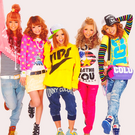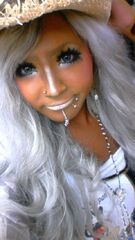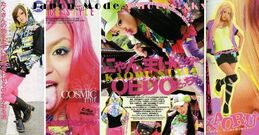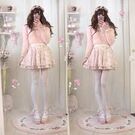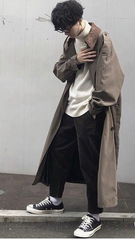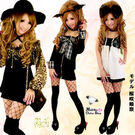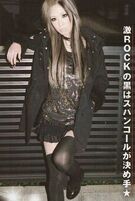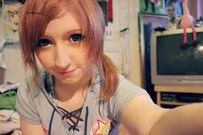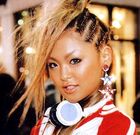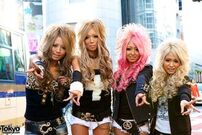Gyaru (ギャル) is one of the oldest Japanese fashions that still exists today. Despite being mostly known for its variant that peaked in the 1990s, it already existed previously in different forms since its name was first coined in 1968. At the height of its popularity, it was not rare to see celebrities spotting this style. The tanned skin, big hair, and rebellious outfits went highly against the traditional Japanese beauty standards. While gyaru appeared very extreme in the past, it toned down as time went on.
For more information on Gyaru culture, please visit the The Gyaru Wikia or Gyaru Wiki for a more comprehensive look into the topic and tell them the Aesthetics Wiki says hi.
Subgenres
Agejo
Agejo is generally worn by, but is not exclusively limited to a hostess. The style is very glamourous and feminine, influenced by expressing a high level of sex appeal through the style and attitude.
This is the style most often shown in the magazine 小悪魔 AGEHA magazine, a popular magazine aimed at young women who love sexy and cute fashion, as well as those who work in the Hostess industry.
Amekaji
Amekaji is a bright, colourful fashion inspired by the ficitionised stereotypical idea of America in the 90's (with a lot of the Amekaji fashion giving off strong Americana vibes). The style is very comfortable and casual, and has been noted to be particularly forgiving to Gyaru of all shapes and sizes as loose fitting clothing is appropriate.
Ane Gyaru
Ane Gyaru is widely considered to be the 'rebellious sister' of Oneegyaru. It is a mature style,similar to Onee, with its own twist. The style is associated with a rough attitude, and it is far more common to see tattoos and piercings in this style compared to many other gyaru styles. Because of the mature nature of the style, this sub-style is seen often on gyaru anywhere from early twenties to mid thirties.
Banba
Banba is a sub-style that developed from Manba. It is sometimes referred to as 'Barbie Style' or 'Barbie Manba' and is considered the toned down version of Manba.
Neon colours are not really seen in this style and hair colours tend to be more toned down. Banba gyaru do have a tendency to wear a lot of glitter as part of their makeup but do not wear stickers on their face like Manba or Yamanba. Banba is a near-extinct sub style of gyaru, with a very small amount of Gyaru, primarily in japan, still wearing Banba.
Bibinba
Bibinba (ビビンバ) is an umbrella term for the Gyaru trend with similar fashion but includes a lot of gold, and jewelry,. It was largely a joke in Egg magazine about this style, and was not a serious style.
Gaijin Gyaru
Gaijin Gyaru is a term used for Gyaru which do not reside in Japan, or in some cases it is meant to mean a gyaru who is not of asian descent.
Ganguro
Ganguro is a type of gyaru consisting of an artificial deep tan and bleached hair; and makeup which tended to use white around the eyes and on the lips and darker shades on the eyes. Also decorations such as glitter or flower such hibiscus flower stickers added on the under part of the eyes. This style was popular in the late 1990s and early 2000s.
Ganjiro
Ganjiro is a Japanese term specifically referring to any Gyaru who follows all of the other GAL trends, except tanning. They even go above and beyond to remain "bihaku" (beautifully white) and apply sun-block, though some ganjiro choose a light bronze skin tone, but they never tan religiously. This came about as a challenge to conventional Gyaru philosophy, namely that it's not the tan that makes you Gyaru, it's the attitude and way of carrying yourself, as well as the fashion you choose to wear. Ganjiro can still be any of the previous fashions other than Gonguro and Ganguro, some even slick on orange make-up and pretend to be Yamanba for a day.
Gyaru Den
Gyaru Den is an attempt at reviving the Gyaru aesthetic through technology. It takes aspects of the gyaru fashion and then makes use of technology as a way to revamp the style; The creators of this style have created all of their items themselves; which can be as LED-lights or synthesizers which are used on accessories such as: necklaces, loose socks or different apparel pieces.
Gyaru Mama
Gyaru Mama is a type of gyaru consisting of teenage gyaru or women who continued with the style even after having children. BBC News states: "Gal-mama are young mothers who refuse to shed their gal-ness."[11] They also would clothe their children in the same style. Meaning a boy would look like a gyaruo while girls would look gyaru but the style would depend on the mothers own personal choice of style or which subculture she belonged to.
Haaady Gyaru
The Haaady Gyaru is one of many popular Gyaru trends in 2007-2008.The term "Haaady" (with 3 "a") was created by Egg magazine to designate the look of her flagship model Kaoru Watanabe. The style "Haaady" is very often called "Kaoru" style "or "Cosmic", "Electric" or "Candy" trend. The word "Haaady" does not come from the English "hard" (it would not make sense) but an exaggerated pronunciation of the Japanese word "hade" (派 手) which means "flashy".
Himekaji
Himekaji (also known as Hime Gyaru or Hime Kei) is a sub-style of Gyaru. It is the casual alternative to Himegyaru and a style that requires less upkeep. The style itself is very similar to that of Roma Gyaru but has its own key differences, including more lace and pink being the most consistent colour used in co-ords. The style itself is often lumped together under the Himegyaru style, but it can be considered its own style. That being said, Himekaji is often worn by many Himegyaru on occasions they wish to go for a more casual and comfortable look.
Kogyaru
Kogal (or kogyaru) is a Japanese fashion culture that involves schoolgirls wearing an outfit based on Japanese school uniform, but with very short skirts. The short skirts are worn irrespective of the season. The girls may also wear loose socks and scarves, and have dyed hair.
Manba
Manba is one of the many sub-styles of Gyaru. It is, alongside Yamanba, a style that developed from the original Ganguro style of gyaru. Manba is pretty much identical from Yamanba with a few small key differences. The most obvious difference is that where Yamanba wear white eyemakeup above their eye, Manba gyaru will wear white eye makeup both above and below. However the line between Yamanba and Manba gyaru is very blurred and the two styles coexist with one another as almost one.
Mode
Mode is a Japanese fashion trend that involves wearing simple black and white clothing and/or accessories. This style is similar to Korean Fashion in many ways, the main one being its simplicity. Mode fashion can include very neutral light colours, or even animal prints (usually seen in handbags and hair accessories)
Ora Ora Gyaru
Ora Ora Gyaru (Highly Active Style) or Ora Ora Kei is a sub-style of Gyaru fashion. The style is a tougher style of gyaru that focuses on black clothes, and being rebellious. Ora Ora can be seen in magazines such as Soul Sister, and Soul Japan. It sometimes includes yakuza-styled tattoos, and high brand accessories. Ora Ora Kei is a continuation of Yanki culture with the addition of Onii-kei gyaru styling.
Rokku
Rokku is a substyle of Gyaru which borrows elements from Rock, Goth, and Visual Kei aesthetics and is notable for being one of only a handful of Gyaru aesthetics that doesn't require one to tan (although piercings and tattoos are particularly popular in this circle).
Romanba
Romanba was a short-lived sub-style of gyaru. It originates from the Manba style, with the 'Ro' standing for Romantic. Often (incorrectly) referred to as 'Lolita Gal', the only similarities this style holds with Lolita is the lace and accessories.
The style was invented by the egg model Ka-Tan and didn't really take off in a big way like other styles, hence why the style is so short lived. Romanba can be considered a mesh of Himegyaru and Manba. The style has a huge feminine focus and features a lot of soft tones and pink is usually the key colour, including the hair colour.
Tsuyome
Tsuyome is a style that contributed to the Gyaru subculture and is an offshoot of Ganguro.
Yamanba
Yamanba (ヤマンバ) was a styles which developed from Ganguro alongside Manba. Old school yamanba and manba(particularly known as 2004 Manba) featured dark tans and white lipstick, pastel eye makeup, tiny metallic or glittery adhesives below the eyes, brightly coloured circle lenses, plastic dayglo-coloured clothing, and incongruous accessories, such as Hawaiian leis. Stickers on the face died out shortly after 2004 and, for a while, yamanba died. Manba then became more extreme, with multicoloured and usually synthetic hair. Manba in 2008 saw a darker tan, and no facial stickers. Hair was usually neon/bright colours, with pink being a favourite. Wool emulating dreadlocks, extensions, and clips were worn to make hair appear longer. Clothing remained the same, although leis were worn less frequently.
Fashion
Gyaru fashion is generally inspired by Western fashion, but there are several subgenres of Gyaru fashion.
Agejo
- Big, intricate hairstyles. Curls and long hair are the most common.
- Hair is often dyed to be light brown or dark blonde. Darker hair is also common.
- Long nails, often with heavy deco
- Gyaru makeup has very thick eyeliner on top and bottom, with thick lashes
- Dolly-style circle lens, various colours are seen
- Colour combinations of clothing is commonly Black X Pink/White/Purple
- Lingerie aspects such as showing a fancy bra, having garter stockings, and corset lacing.
- Tight clothing, often dresses or skirts are worn and very short.
- Brand-name bags and jewelry
Amekaji
- Bold, brightly coloured prints
- Cute patterns and slogan tees
- Hats are often worn, such as baseball caps and beanies
- Jeans, shorts and skirts are common. Dresses aren't seen often
- Simple gyaru makeup
- Tan ranging from medium to heavy
- Lingere aspects such as showing a fancy bra, having garter stockings, and corset lacing.
- Hair is often bleached to various shades of blonde
- Flat shoes, such as sneakers or ballet flats
Ane Gyaru
- Tans are seen but not essential
- Hair is often soft blondes, browns or black
- Black is the most prominent colour in clothing
- Heels and boots are the most common footwear
- Sense of rebellion, but classy
- Leopard print is seen but not to excess
- Leather and fur are common
Banba
- Hair is often bleached to be blonde or dyed brown
- Medium tan, sometimes darker tans are seen
- Long nails, sometimes with deco
- Subtle more toned down Manba makeup
- Dolly-style circle lens, various colours are seen
- Clubwear
Haaady Gyaru
- fluo color mix with touches of black
- Sweatshirt
- Tee-shirt
- Cap
- High heels
- Mini skirts
- Makeup
- Colorful makeup with equally colourful hair
- Accessories and prints related to hero cartoons or cosmic references
Himekaji
- Hair is often bleached blonde or lighter shades of brown
- Hair is curled, and can be long or short. Often worn down
- The most prominent colour is pink, and most outfits will always feature something pink
- Clothes are comfortably but flattering
- Less accessories than Himegyaru
- Nails are long but not as often decorated, and if they are, it is not excessive
- Like Himegyaru, Liz Lisa is a big brand for Himekaji
- Roses and hearts are common patterns
Manba
- Heavy white makeup around eyes, on nose and around lips
- Hair is often bleached blonde, or dyed unnatural colours
- Long nails, often with heavy deco
- Bright colourful clothing
- Stickers and decorations on the face as a part of makeup
- Heavy deco on accessories such as cell phones
Mode
- Oversized trench coats, Long puffer coats, and (long or short bubble jackets)
- Wide-leg trousers
- slacks
- turtlenecks
- wooly-like textiles
- turtlenecks
- light blouses/shirts
- floral skirts
- grid patterns
- oxfords, mary janes, heels and heeled boots
- converse, black or white shoes/sneakers
- simple wristwatches, rings, necklaces
- long and/or comfy cardigans
- light/dark socks or dark stockings
Ora Ora Gyaru
- Black/dark clothing
- Caps are often worn
- Tracksuits, tees, and hoodies are common staples
- Relaxed hairstyles, with shaved heads not uncommon
- Hair colours vary from black to blonde
- A lot of heavy focus on eye makeup
- Lips tend to be nude, and cheeks are more often orange or brown than pink
Romanba
- Heavy white makeup around eyes, on nose and around lips
- Hair is often bleached blonde or pink
- Long nails, often with heavy deco
- Lots of pink clothing
- Lace on clothing and accessories is common
- Stickers on face are usually pink flowers or hearts
Gyaruo
A Gyaruo is a male Gyaru. Typically, Gyaruo have similar elements to their appearance with Gyaru in terms of having high volume styled hair, trendy fashion styles, and sometimes tanned skin.
Gyaruo Media
Magazines
- Men's Egg
- Men's Egg Bitter
- Men's Digger
- Men's Knuckle
Gyaruo Subcultures
- Military (ミリタリー系) - uses camo print and muted colors
- Rock (ロック系) - closer to Western fashion of the 90s, lots of black and skull prints
- Biker (バイカー系) - leather jackets, jeans, and motorcycles
- American Casual (アメカジ系) - uses bright colors, multiple layers, and graphic clothing with English slogans/words
- Surfer (サーファー系) - summer clothing, bright pastel colors
- Adult (お兄系) - popular among older gyaruo, often a bit more subdued than the average gyaru look
- Sentaa Guy (センターガイ) - Gyaruo's in Ganguro drag
Neo-Gyaru
Neo-gyaru is an to revitalize the Gyaru style during the 2010s during its decline. But when the style reached popularity or even realization that it existed, the gyaru community reacted in a completely different way then what some anticipated, they completely shunned the style. But those who were wearing said fashion were not using the same fashion style as before or in its traditional form to wear; from apparel to there makeup.


